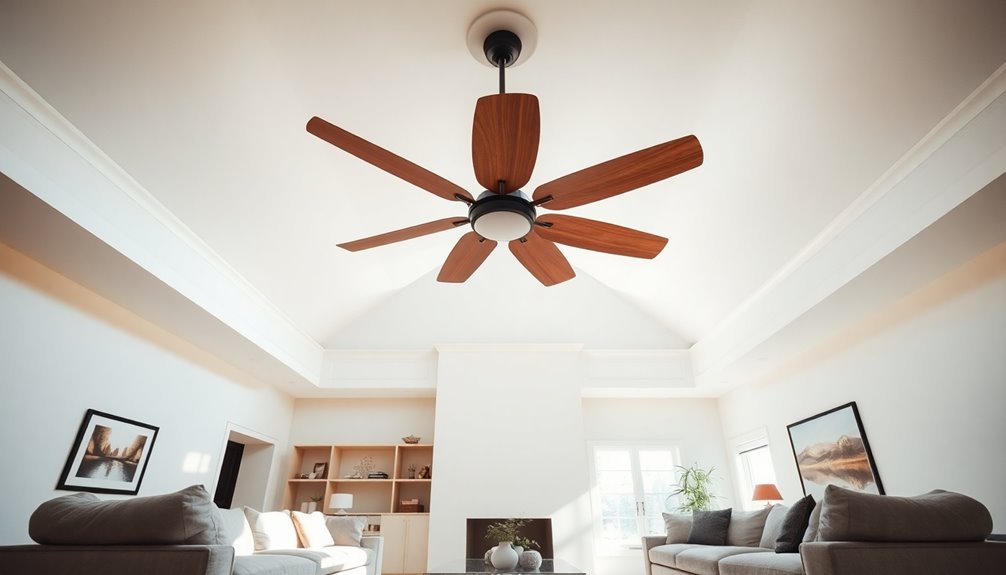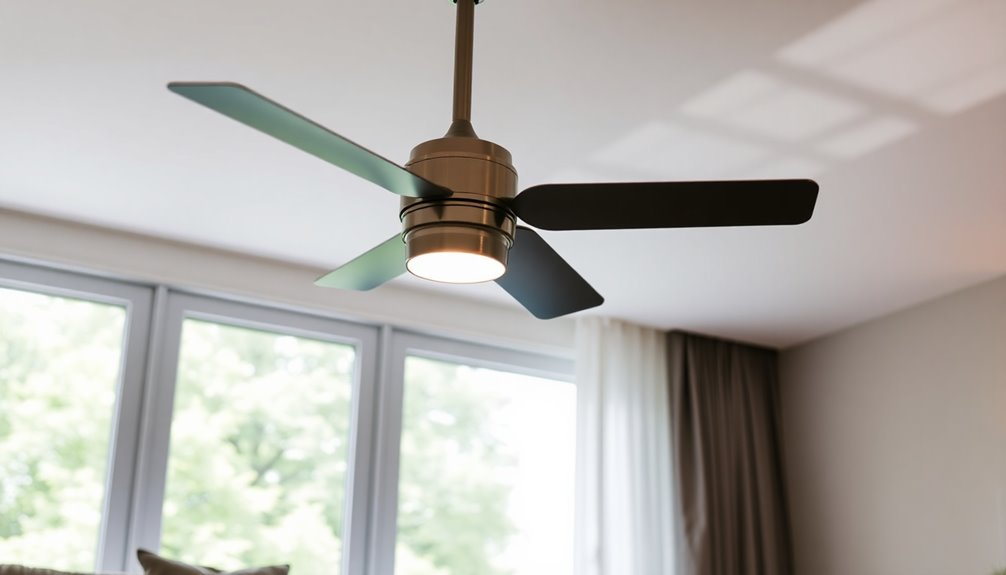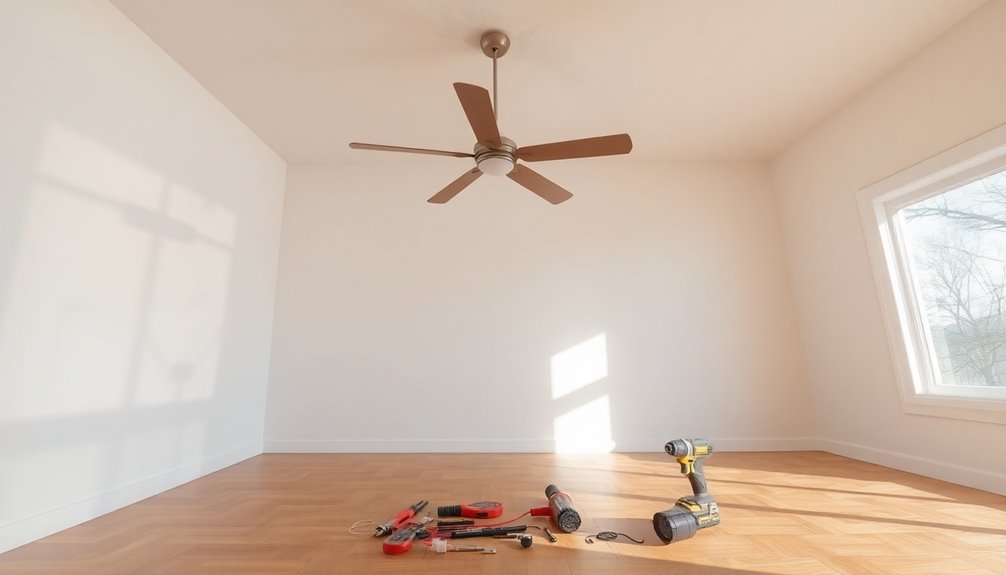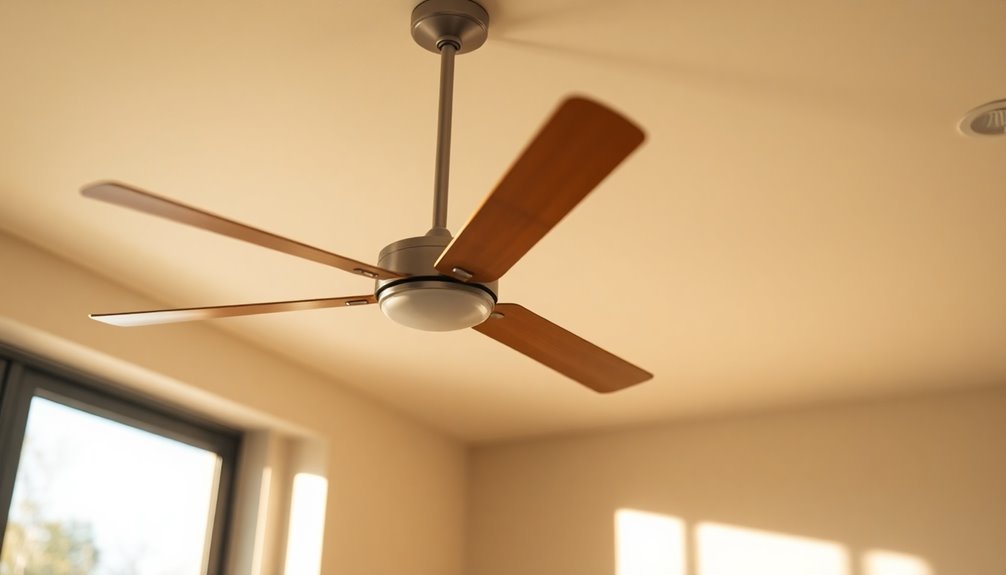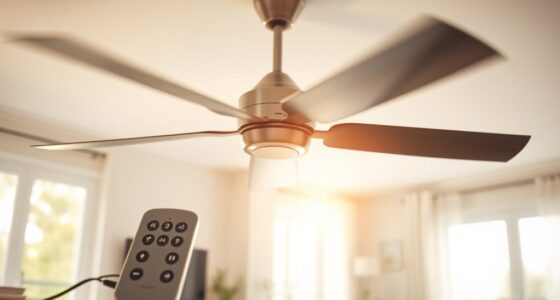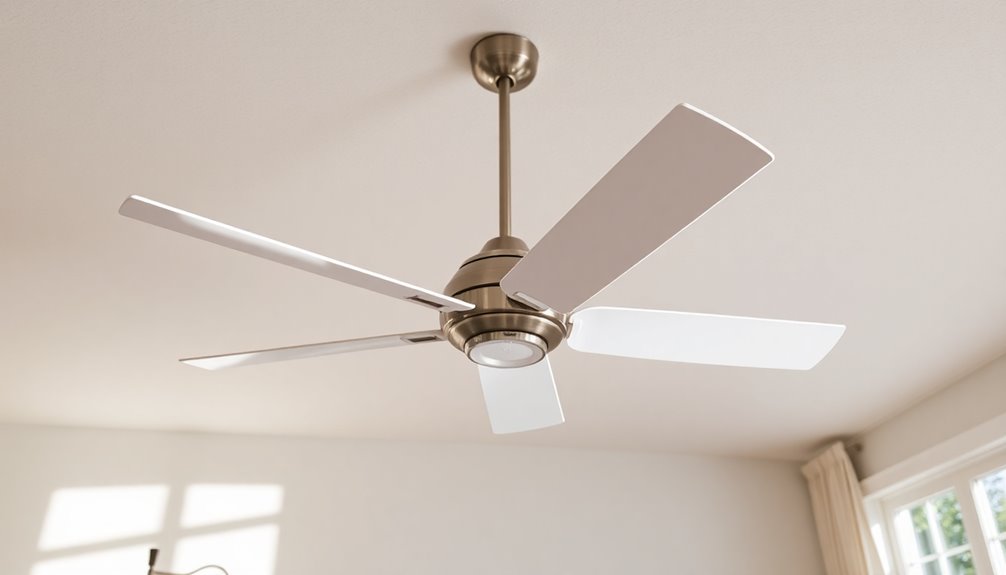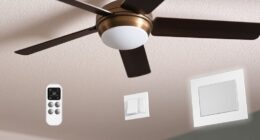Yes, a ceiling fan can definitely be too big for a room. If the fan's blade span exceeds the recommended size for your space, it can dominate the room, making it feel cramped. Oversized fans can create excessive airflow, resulting in cold drafts that disrupt your comfort. Additionally, larger fans might consume more energy and lead to increased noise levels. For proper sizing, refer to guidelines that recommend blade spans based on room size. Understanding these factors can help you select the right fan that enhances your space without overwhelming it. There's more to evaluate when choosing the perfect fan for your room.
Key Takeaways
- Oversized fans can dominate small spaces, creating a cramped and uncomfortable environment.
- Excessive airflow from large fans may result in cold drafts, leading to discomfort.
- Larger fans can be energy inefficient, using more electricity than necessary for small rooms.
- Clearance issues may arise with oversized fans, complicating installation and affecting airflow effectiveness.
- Oversized fans can create increased noise levels, disrupting quieter spaces and contributing to an unpleasant atmosphere.
Understanding Ceiling Fan Size

When choosing a ceiling fan, understanding the right size for your room is essential to ascertain comfort and efficiency. The ceiling fan size directly affects both airflow and the overall aesthetic of your space.
When you opt for large ceiling fans in smaller rooms, you risk overwhelming the area, making it feel cramped and lowering the visual height of the ceiling. Ideally, small ceiling fans with a blade span of 36 inches or smaller work best for rooms up to 100 sq ft.
For larger rooms, typically ranging from 200 to 400 sq ft, you should consider fans with a blade span of 52 inches or more. This guarantees the airflow is adequate, preventing the fan from straining, which can lead to motor burnout when used in undersized spaces.
Conversely, smaller fans in larger areas struggle to circulate air effectively, leaving you feeling uncomfortable. By maintaining appropriate proportions between fan size and room dimensions, you enhance energy efficiency and comfort, ensuring airflow remains pleasant without being overpowering.
Choosing the right ceiling fan size is key to creating a comfortable environment in your home.
Effects of Oversized Fans

Choosing the right ceiling fan size is essential, but opting for an oversized fan can lead to a range of issues. Oversized ceiling fans can dominate your space, making it feel cramped and lowering the perceived ceiling height.
You might find that the excessive airflow creates discomfort, as the strong breeze can be too cold or disruptive in smaller rooms.
Here are some potential drawbacks of oversized ceiling fans:
- Energy inefficiency: Larger fans often use more electricity without delivering proportional cooling benefits, leading to higher utility bills.
- Clearance issues: Installing a fan that's too big can require greater distances from walls and ceilings, complicating installation and reducing effective airflow.
- Noise levels: Bigger fans may operate at higher RPMs, resulting in increased noise that can be disruptive in quieter environments.
Guidelines for Fan Sizing

Finding the right ceiling fan size for your room is essential for both comfort and aesthetics. Choosing the appropriate ceiling fan size guarantees ideal airflow and enhances your space without overwhelming it.
Here are some guidelines to help you select the right fan based on your room size:
| Room Size | Recommended Blade Span |
|---|---|
| Small Rooms | 29 to 36 inches |
| Medium Rooms | 42 to 48 inches |
| Large Rooms | 52 to 56 inches |
| Very Large Rooms | 60 inches or wider |
| Multiple Fans | Needed for very large rooms |
For small rooms under 100 sq ft, a fan with a blade span of 29 to 36 inches is ideal to guarantee adequate airflow. Medium rooms (100 to 175 sq ft) benefit from fans with a 42 to 48-inch span. In large rooms (175 to 350 sq ft), aim for fans between 52 to 56 inches for effective circulation. For very large areas over 350 sq ft, consider fans that are 60 inches or wider, or use multiple fans to achieve balanced airflow.
Airflow and Performance

Airflow and performance are closely linked to the size of your ceiling fan. If you're using an oversized fan in a small room, you might create excessive airflow that leads to uncomfortable drafts. Larger fans produce more cubic feet per minute (CFM) of airflow, but in confined spaces, this can be wasted, causing energy inefficiency.
Here are some important considerations:
- Oversized fans can struggle to operate efficiently in small rooms, risking motor burnout.
- Airflow diminishes considerably beyond two feet from the fan's radius, making large fans less effective.
- A fan that's too big can disrupt airflow dynamics, leading to uneven cooling.
- Understanding energy efficiency is crucial in selecting the appropriate fan size for your space.
Choosing the right ceiling fan size is vital for ideal performance. In smaller rooms, a fan that matches the space can provide a comfortable breeze without overwhelming drafts.
On the other hand, an oversized fan can create a noisy, uncomfortable environment and waste energy. To enhance both comfort and efficiency, consider your room size carefully when selecting a ceiling fan.
Finding the right balance guarantees you get the airflow you need without the drawbacks of energy inefficiency.
Ceiling Height Considerations

How do ceiling height considerations impact your ceiling fan's effectiveness? The height of your ceiling plays an essential role in determining how well your fan performs. For ideal airflow efficiency, you should maintain a minimum clearance of 7 feet from the floor to the bottom of the blades.
If your ceiling height exceeds 8 feet, using downrods is necessary to lower the fan, guaranteeing it circulates air effectively throughout the room.
Installing a fan too close to the ceiling can lead to reduced airflow efficiency, creating a "cocoon effect" where air is trapped and doesn't circulate properly. In rooms with lower ceilings, opt for flush mount fans. They help maintain adequate clearance and prevent obstruction, allowing for better air movement.
Additionally, it's critical to keep an 18-inch distance between the fan blades and the walls. This distance not only promotes safety but also maximizes airflow efficiency.
Aesthetic Impact of Fan Size

Often, the size of your ceiling fan considerably influences the overall aesthetic of a room. An oversized ceiling fan can dominate your visual space, making a smaller room feel cramped and reducing the perceived ceiling height. This can clash with your design theme, overpowering other decorative elements and creating an imbalance that detracts from your aesthetic appeal.
To guarantee your ceiling fan enhances rather than hinders your room's look, consider these factors:
- Proportions: A fan should complement the room's scale; a 60-inch fan suits rooms between 12×12 ft to 16×16 ft for ideal harmony.
- Color and Style: Bold designs on oversized fans can draw too much attention, overshadowing other decor.
- Visual Clutter: Properly sized fans enhance the room's aesthetic, while oversized fans can create a sense of visual clutter that disrupts cohesion. Additionally, choosing a fan with high CFM ratings can ensure efficient airflow without overwhelming the space.
Choosing the Right Brand

Finding the right ceiling fan brand can greatly enhance both the functionality and style of your space. When you're choosing the right brand, consider factors like blade span and airflow efficiency. Established brands like TroposAir and Fanimation are known for their quality materials, ensuring durability and performance.
Here's a quick comparison of some popular brands:
| Brand | Features |
|---|---|
| TroposAir | High airflow, stylish design |
| Fanimation | Remote controls, smart home compatible |
| Hunter | Classic styles, reliable performance |
Selecting the right size ceiling fan from these established brands can make a significant difference in your room's comfort. Larger fans typically produce the best airflow, enhancing cooling in spacious areas while maintaining lower RPMs for quieter operation. You'll want to avoid cheaper models that often face issues like noisy operation or blade drooping.
Installation Tips for Fans

Installing a ceiling fan correctly is essential for both safety and peak performance. To maximize air circulation and guarantee the fan works efficiently, follow these installation tips:
- Height Matters: Install your ceiling fan at least 7 feet above the floor. If your ceiling is over 8 feet, use downrods to bring the fan to the ideal height.
- Clearance Counts: Maintain a minimum clearance of 18 inches between the fan blades and walls. This prevents airflow obstruction and boosts efficiency.
- Multiple Fans for Large Rooms: In larger spaces, consider installing multiple fans to evenly distribute air without overwhelming the room's size.
If you're dealing with angled ceilings, don't forget to use sloped mounts to align the fan properly. This not only enhances safety but also guarantees the ceiling fan operates at its best.
Maintenance for Optimal Performance

Maintaining your ceiling fan is essential for guaranteeing ideal performance and longevity. Regular maintenance helps prevent dust buildup on the blades and motor components, which can hinder airflow and diminish performance. Start by cleaning the blades and motor regularly to keep everything running smoothly.
Next, inspect your fan for any loose screws or bolts. Tightening these can greatly reduce wobbling and noise, contributing to a more enjoyable experience.
Additionally, lubricate the fan motor and bearings per the manufacturer's recommendations to maintain optimal performance and minimize wear over time.
Don't forget to check pull chains and electrical connections periodically. This guarantees they function correctly and safely, reducing the risk of potential malfunctions.
Finally, monitor the fan's airflow direction seasonally. Adjusting it to run counterclockwise for summer cooling and clockwise for winter warmth can maximize efficiency and comfort in your space.
Selecting Fans for Different Rooms

Choosing the right ceiling fan for each room is essential for achieving ideal comfort and air circulation.
Selecting the appropriate size fan based on your room's square footage is an important factor that can notably affect your comfort level.
Here's a quick guide to help you:
- Small Rooms (up to 100 sq ft): Use a fan with a blade span of 36 inches or smaller.
- Medium Rooms (100-200 sq ft): Opt for fans with a blade span between 42 to 50 inches.
- Large Rooms (over 200 sq ft): Choose fans with a blade span of 52 to 60 inches; for very large rooms (over 400 sq ft), consider multiple fans.
Frequently Asked Questions
Is It OK to Oversize Ceiling Fan?
When you think about oversizing a ceiling fan, it might seem like a good idea for maximum airflow, but it can lead to problems.
You'll notice excessive airflow that feels drafty, which isn't comfortable. Plus, a large fan can dominate your room's aesthetics and make the space feel cramped.
You might also end up wasting energy if the fan runs inefficiently.
Can I Put a Big Ceiling Fan in a Small Room?
You don't want to throw caution to the wind when considering a big ceiling fan for a small room.
A large fan can create too much airflow, making you feel uncomfortable and drafty. It might also block ceiling height, making your space feel cramped.
Stick to fans under 42 inches for rooms smaller than 100 square feet to guarantee effective air circulation and avoid unnecessary energy use and potential motor burnout.
Is a 52 Inch Fan Too Big for a 12X12 Room?
A 52-inch ceiling fan isn't too big for a 12×12 room. It effectively circulates air, keeping you comfortable without overwhelming the space.
Just make sure to mount it at least 7 feet above the floor and maintain an 18-inch clearance from the walls to optimize airflow.
If your ceiling is low, consider a flush mount to avoid any obstruction.
Ultimately, it'll depend on your preferences for airflow and the room's overall design.
How Big Should My Ceiling Fan Be for My Room?
To choose the right ceiling fan size for your room, measure your space first.
For small rooms under 100 sq ft, go for a fan with a 36-inch blade span.
If your room is medium-sized (100-200 sq ft), pick a fan between 42 to 50 inches.
For larger areas (200-400 sq ft), opt for a 52 to 60-inch fan.
This guarantees you'll enjoy ideal airflow and comfort without overwhelming your space.
Conclusion
In the end, choosing the right ceiling fan is like finding the perfect puzzle piece—it needs to fit just right for everything to come together harmoniously. An oversized fan can overwhelm a small room, creating a whirlwind instead of a gentle breeze. By considering size, airflow, and ceiling height, you can guarantee your fan enhances comfort rather than detracts from it. So, take your time, and make certain your fan is just the right fit for your space.
